Final report for OW16-022
Project Information
Mixed-species cover crop plantings (aka Cover Crop Cocktails) offer multiple benefits to producers. Through a collaboration with five Oahu-based producers, this project aimed to identify viable cover crop cocktails for producers in Hawaii. Research and field demonstrations were used to evaluate economic costs, and to measure effects of cover crop plantings on soil health. Information was shared with producers through on-farm field days, presentation at the Hawaii Ag Conference, and through Oahu RC&D's updated Cover Crop Handbook.
Project Objectives and Target Dates:
- Identify cover crop species currently used and available in Hawaii.
- Conduct a survey of cover crop users, seed sales locations, and agricultural professionals to identify which cover crop species are currently in use / October 2016.
- Summarize information related to planting rates, costs, days to maturity, etc. / November 2016.
- Utilize information to determine cover crop cocktail mixes and planting rates / December 2016.
- Evaluate economic costs and soil health benefits of mixed-species cover crop plantings.
- Summarize economic costs (ie. cost of seed per acre) of cover crop cocktails / January 2017.
- Establish five demonstration plots in diverse geographic locations on Oahu / May – September 2017.
- Conduct physical, chemical, biological, and agronomic evaluations at pre-project and post-project intervals / approximate dates: March 2017, September 2018:
- Physical: moisture, temperature, bulk density.
- Chemical: pH, total nitrogen, total carbon, phosphorus, potassium.
- Biological: presence of earthworms, soil respiration (Solvita).
- Conduct agronomic evaluations of two seasons of cover crop cocktail plantings on cooperating farms:
- Agronomic: biomass of cover crop and, where feasible, weeds (used to determine relative weed suppression), percent soil coverage, presence of beneficial insects, estimated plant available nitrogen (tissue culture and cover crop calculator tool from the University of Hawaii CTAHR).
- Identify obstacles (“pain points”) and potential solutions for small farms adopting cover crop cocktails in Hawaii.
- Gather anecdotal feedback and observations from host farms following each planting / March 2018, December 2018, and throughout project period.
- Facilitate collaborative learning process through data collection, experimentation and feedback from technical advisors / throughout project period
- Summarize lessons learned to inform decision-making about cover crop cocktail use at the farm-level and simplify the on-boarding process for farms adopting cover crops. / December 2018
- Document pros and cons of different field practices and equipment used by participating farms. / December 2018
- Share results with producers and other agricultural professionals.
- Employ surveys to gauge familiarity with common cover crop species / October 2016, July 2018, March 2019.
- Hold two field days to demonstrate cover crop cocktails. Field days will be held at host sites, and will include presentations from the host farmer(s), 2-4 agricultural professionals on featured topic(s), and a tour or hands-on activity / September 2017, September 2018.
- Incorporate findings into a revised edition of the Cover Crop Handbook produced by Oahu RC&D / March – June 2019.
- Present findings at the 2017 Hawaii Agriculture Conference (or similar venue) / August 2017.
- Disseminate resources, results and related information via social media networks and producer-to-producer networks / entire project period.
Cooperators
- (Educator and Researcher)
- (Educator and Researcher)
- (Researcher)
- (Researcher)
- (Researcher)
- (Researcher)
- (Researcher)
Research
Project methods are outlined in the objectives and target dates.
Our call for collaborators for the cover crop cocktail trial received strong interest from small-scale vegetable producers using organic practices. Having worked closely with large-scale operations to develop and promote cover crop practices appropriate for Hawaii's farms and soils in the past, we seized on this as an opportunity to extend the use of cover crop technologies to a broader audience in our state. As we implemented our first round of on-farm field trials in 2017, our choice to collaborate with small farms coupled with our participatory research process uncovered a number of unforeseen challenges as well as a number of insights to tailor our methods to better serve Hawaii's small farm sector:
- None of the cooperating farms in the trial possess grain drills, no-till drills, roller-crimpers, flail mowers, or other equipment commonly used to manage cover crops and frequently cited in cover crop extension literature. Two of the farms do not possess or have reliable access to tractors. Additionally, the focus of our cooperating farmers on vegetables and tree crops (bananas, breadfruit, tropical fruit) results in a shortage of experience regarding the field practices used to plant and terminate cover crops. We adjusted to these challenges by broadening our research process to document farmer feedback on the obstacles or "pain points" they encountered during the 2017 cover crop trial, the results of which we incorporated into our 2018 field day topics and subsequent cover crop manual update. We also reduced the size of the trial plots not only to accommodate the size and cropping system of each farm, but also to reduce the potential for costly negative impacts on subsequent cash crops given the amount of problem solving (and likelihood of mistakes) required to overcome relative inexperience and equipment limitations.
- Our cooperating farmers work in drastically different soils (e.g. vertisol, oxisol, mollisol), and growing conditions, including variations in annual rainfall between 700 and 1,100 mm. and annual solar radiation between 160 and 210 W / sq. m. Hawaii's tropical growing conditions allow for year-round production and varied timing of cover crop usage, contrasting with the seasonally-dictated seasons for cash and cover crops that prevail on the mainland US. This complicated our goal of identifying uniform, effective cover crop cocktails and seeding rates to promote, but forced us to recognize the challenges confronting farmers interested in adopting cover crops in Hawaii. We adapted to this by taking a two-prong approach:
- We trialed a uniform cover crop cocktail recipe across all farms during two seasons (2017-2018) in an attempt to identify a "one size fits all" recommendation, which we anticipate being of use to the most farms possible, especially first time cover croppers.
- During the trial's second season, each farm developed a custom cover crop cocktail tailored to their specific cropping system and growing conditions. We anticipate these blends being useful to farms with similar growing conditions and/or cropping systems on all islands in the state. We found that farm-level participation in the trial design tapped into more creativity and deep site knowledge.
- We adjusted the methodology to better integrate farmer participation, innovation and learning, as outlined in objective three.
- We integrated a tool developed in 2017 by Dr. Wang of UH CTAHR, in conjunction with Oregon State University faculty, called the Hawaii Cover Crop Calculator. This tool provides a protocol and spreadsheet to estimate the plant available nitrogen provided by a cover crop in several of Hawaii's most common agricultural soil classes. We "road-tested" this tool to assess its value for small farmers and provide better information for farm-level decision-making regarding cover crops adoption and use.
Two seasons of cover crop plantings was completed on cooperating farms during the summers of 2017 and 2018. The 2017 plantings provided valuable feedback that was incorporated to improve the 2018 plantings and field day:
- It was not allowed or advisable to ship the fresh sample tissue cultures for analysis to out-of-state lab used for soil testing. Several different drying facilities were used as a result, which may have skewed the results of the analysis. Preparations are being made to use a single facility for analysis of the 2018 plantings.
- Integrating farmers into the field work to collect data on the cover crop was an invaluable opportunity to spend quality time assessing the cover crop and gathering feedback. However, field work needs to be completed in 1-2 hours in order to fit into their schedules. We were able to secure an additional staff member for only one of the data collection field visits in 2018. The shortage of help in the field limited data collection on weed abundance and soil moisture.
Cover Crop Cocktails for Small Farms: Species and Seeding Rates
| Site 1 | Site 2 | Site 3 | Site 4 | Site 5 | ||||||
| Seeding Rate (lb/ac) | 92 | 125 | 92 | 125 | 92 | 128 | 92 | 126 | 92 | 115 |
| Cover Crop | SH/BW/O1 | CC2 | SH/BW/O1 | CC3 | SH/BW/O1 | CC4 | SH/BW/O1 | CC5 | SH/BW/O1 | CC6 |
| Dry Matter (lb / ac) | 3,045 | 4,636 | 2,462 | 2,140 | 4,621 | 4,146 | 2,869 | 3,874 | - | - |
| C:N | 16 | 13 | 12 | 12 | 21 | 13 | 17 | 13 | - | - |
| PAN (lb/ac) | 28 | 51 | 34 | 33 | 64 | 101 | 33 | 60 | - | - |
| Seed Cost ($/ac) | $205 | $328 | $333 | $458 | $333 | $558 | $205 | $451 | $205 | $326 |
| Fertilizer Savings ($/ac) | $9 | $17 | $11 | $11 | $21 | $33 | $11 | $20 | - | - |
1 SH/BW/O: Sunn Hump, Buckwheat and Oats; objective: good general performance in a wide variety of conditions to generate biomass, fix nitrogen and suppress weeds.
2 Site 1 Custom Cocktail (CC): Sunn hemp, black oats, lablab, sorghum-sudan, pearl millet and graza radish; farm objective: reduce soil compaction, improve soil texture and suppress weeds.
3 Site 2 Custom Cocktail (CC): Buckwheat, lablab, alfalfa, sunn hemp; farm objective: weed suppression, increase soil organic matter, fast break-down of crop residue, and attract beneficial insects.
4 Site 3 Custom Cocktail (CC): Sunn hemp, black oats, lablab, sorghum-sudan, tillage radish, cow pea; farm objective: contribute nitrogen and organic matter to soil.
5 Site 4 Custom Cocktail (CC): Sunn hemp, lablab, sorghum-sudan pearl millet, graza radish; objective: weed suppression, organic matter, transition to perennial cover for orchard crop.
6 Site 4 Custom Cocktail (CC): Sorghum-sudan, buckwheat with a small amounts of basil and cilantro; objective: add organic matter and have a flexible termination date with the option to mow and let cover crop regrow to prolong cover.
Obstacles (“pain points”) for small farms adopting cover crop cocktails in Hawaii.
Farmer-researchers in our trial reported a number of stumbling blocks caused by gaps in their knowledge or skills managing cover crops, or by external factors such as disease or seed cost and availability:
- Irrigation - Most of the farmer-researchers use drip irrigation systems for vegetable production and encountered setbacks when installing or using overhead irrigation for germination and growth of their cover crops.
- Weed management - the aggressive, existing seed bank was not effectively suppressed by the cover crop either due to a lack of vigor from cover crop species or poor establishment, especially when farms are first experimenting with cover crops and the growing techniques..
- Inadequate equipment -
- Farms did not own or have access to the equipment, such as seed drills, roller crimpers and flail mowers, that facilitates effective and efficient seeding and termination of cover crops.
- Recommended seeding rates intended for seed drills were consistently much too low for broadcasting.
- The small-scale roller crimpers trialed at our field days (with walk-behind tractors) were not functional enough to encourage adoption and organic growers discarded roller-crimping as an option due to the presence of aggressive, vining weeds that invade the crimped cover crop residue.
- Brush hog-type rotary mowers leave chunky crop residue that cannot be easily tilled in within the timeframe required by small-scale vegetable farmers.
- Inconsistent availability of high-quality cover crop seed - the companies that provide cover crop seed in Hawaii struggle to provide a consistent, diverse supply of cover crops and seed is compromised by the conditions during maritime freight, causing poor germination. Sourcing seed from mainland companies is possible, but involves higher cost due to shipping fees and requires more time.
- In the case of sunn hemp, the growth and management of the cover crop was made more difficult by diseases, including a kind of wilt.
- Seeding the different sizes and shapes of seeds in a cocktail presents challenges.
We designed our field day methodology in 2018 to provide better information and training, as well as incorporating recommendations on how to avoid or mitigate these common problems in an update to our cover crop handbook.
Research Outcomes
Education and Outreach
Participation Summary:
2018-2019
In January 2018, Jayme Barton and Dave Elliott visited the farms participating in the trial's second season and designed a custom cover crop cocktail with each farmer-research to address their individual soil health objectives, production system and growing conditions (including a steep precipitation gradient and different soil types across the island).
In April, 2018, project coordinator Dave Elliott and GoFarm Hawaii coach Jay Bost shared information about cover cropping and cover crop cocktails with the graduating cohort of the program's AgPro advanced course. Each student selected one cover crop cocktail mix that had been designed by farmer-researchers participating in our on-farm trial and then planted that mix on the 1/8 acre plot they had farmed during their six-month course.
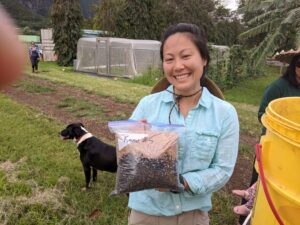
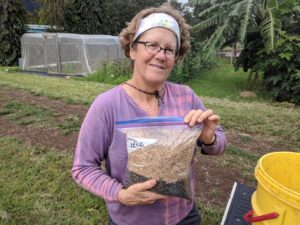
In June 2018, we conducted a cover crop cocktail field day designed to provide hands-on experience and get farmers "on board" with cover cropping. The event was co-led by GoFarm Hawaii and made use of the six different cover crop cocktails planted in demo plots with their AgPro students two months prior. Project coordinator Dave Elliott worked with Jay Bost for the event to address the common stumbling blocks for new farmers and farmers new to cover cropping. After technical advisor Jayme Barton provided an intro talk on the benefits and challenges of working with cover crop cocktails, hands-on stations allowed participants to broadcast cover crop into a prepared field, operate and compare a flail mower and a roller crimper to terminate cover crops, and install over head irrigation in a newly seeded field. Before concluding the half-day event, attendees did a walk through and assessment of the different 1/8 acre cover crop cocktails with Jayme Barton, Dave Elliott and several of the farmer-researchers participating in our trial: Daniel Leas of Counter Culture Farm, Christian of Kahumana Organic Farm and Jay Bost of GoFarm Hawaii. This provided valuable insights for participants on the performance of different cover crop species and how these small-scale commercial farms integrated cover crops into their operations. The demo plantings also allowed the farmer researchers to make final adjustments to the seeding rates and species for the cocktails they had designed and would plant during the on-farm trial's second season.
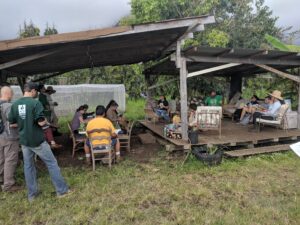
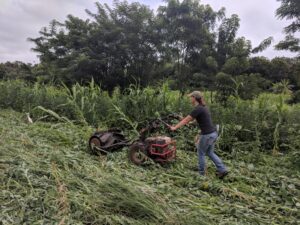
In June and July of 2018, the project's technical adviser, Jayme Barton, provided consulting to the Hawaii Farmers' Union United to plan a demo cover crop cocktail planting at the site of their 2018 Convention, which was held in October on Maui. The demo planting was well situated between the parking area and the event grounds, such that everyone arriving to the event was greeted by the yellow flowers of the sunn hemp. The HFUU organized a demonstration of a roller-crimper during the event, accompanied by talks from multiple soil health experts, including Bob Shaffer (Soil Health Co.) and Dr. Jen Kucera (NRCS). Oahu RC&D setup an outreach table at the event to talk story about cover crop cocktails and species and engage with attendees over two days of the event.
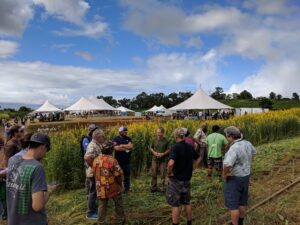
In October 2018, project coordinator Dave Elliott designed and conducted a cover crop lab with students in UH Leeward Community College's Horticulture 110 course. Students learned about the benefits and challenges of using cover crop cocktails and selecting different cover crop species based on a farm's soil health objectives and production system. Oahu RC&D had designed two cocktails for use at the Leeward Community College campus farm and the lab was conducted with this planting. In addition to assessing the growth forms of the different cover crop species in the planting, the Horticulture 110 students assessed the fresh weight of each cover crop species and weeds in the parcel by using a quadrat sampling methodology that allowed them to estimate the per acre values. They subsequently dried the samples and estimated the total biomass production per acre of the cover crop planting. Though the absence of lab equipment prevented them from assessing the nitrogen content of the samples, the potential for cover crop residue to displace fertilizer requirements was discussed.
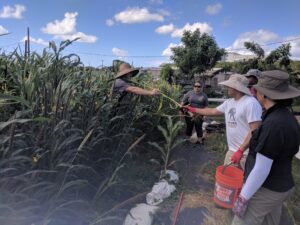
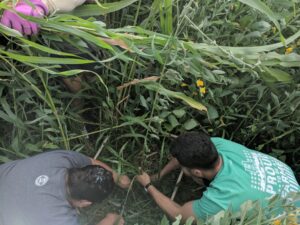
In April 2019, project coordinator Dave Elliott designed a drought-tolerant, low management cover crop cocktail (buckwheat, cow pea, pearl millet and sweet alyssum) for the use of the Kokua Foundation's "'Aina in Schools" garden-based learning program. The program's coordinator contacted Oahu RC&D in search of a cover crop solution to improve the soil health in the raised gardening beds at 23 elementary schools during the summer break.
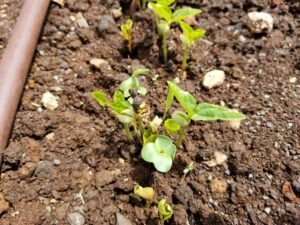
In April, Oahu RC&D created a new educational tool by updating our 2011 Cover Crop Handbook with results and lessons learned from this project and making it available in a webpage format (the educational tool is available in the link).
2017
In 2017, we organized a well-attended cover crop cocktail field day at Kahumana Farm in conjuction with their annual Farm Fair. Through partnerships, the field day featured an all-star panel of soil health experts and farmers: Dr. Jen Kucera (NRCS), Gabe Brown (Brown's Ranch), Bob Shaffer (Soil Culture Co.) and Jayme Barton (HARC and project technical advisor). In addition to small group time with all of the panel experts, participants had the opportunity to evaluate a six species cover crop cocktail alongside single species plots of each of the species in the cocktail (sunn hemp, lab lab, oilseed radish, black oats, buckwheat, sorghum-sudan grass).
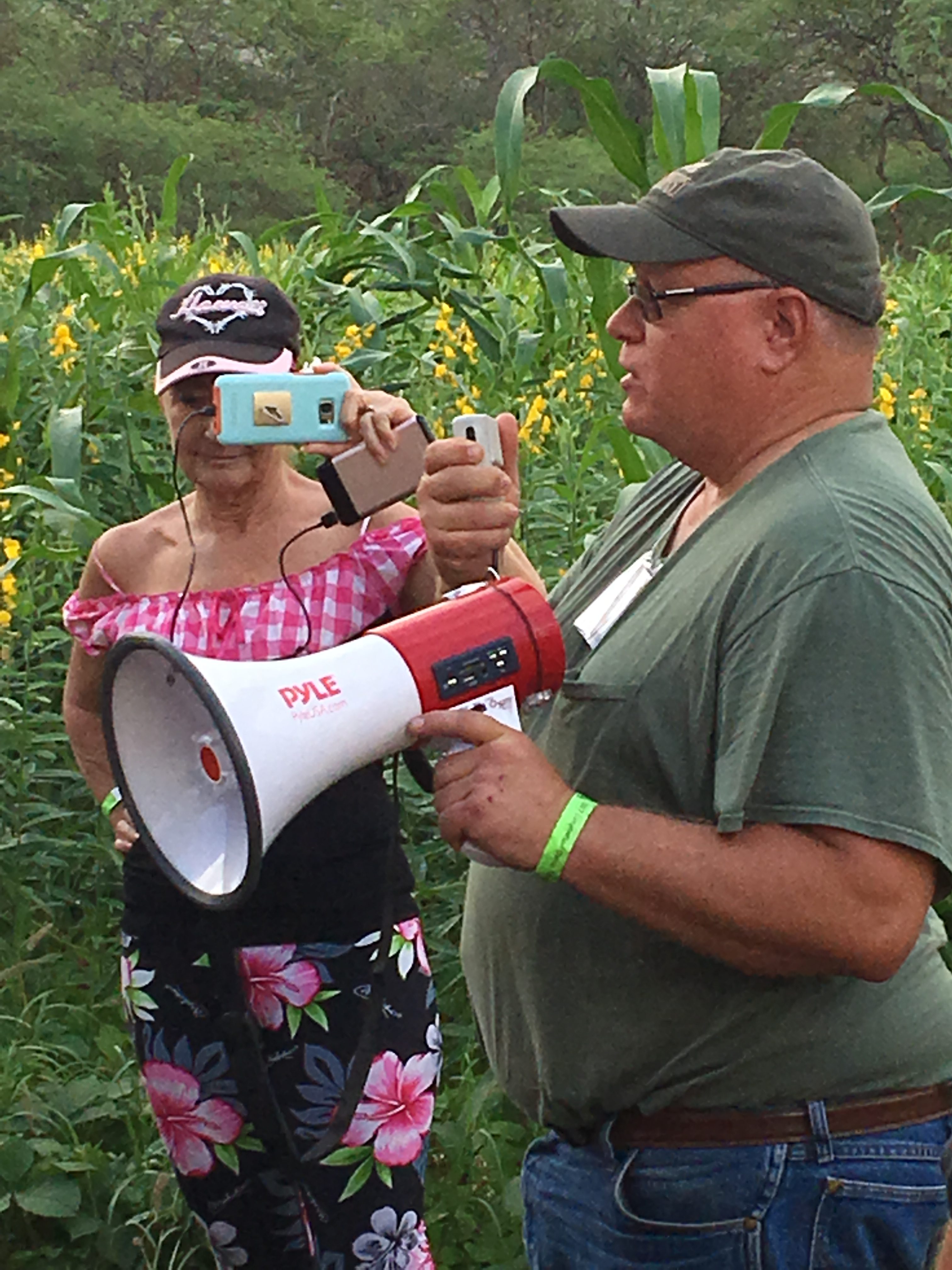
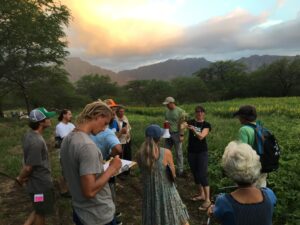
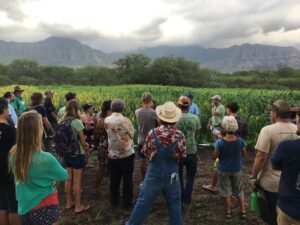
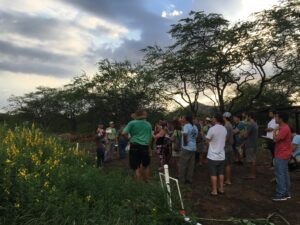
In 2017, the project coordinator gave three presentations on cover crop cocktails to groups of farmers at the following events: Hawaii Farmers' Union United Annual State Convention, No-Till, Small-Scale Farming Workshop (one event on the island of Oahu and a duplicate event on Hawaii Island) (See attached: HFUU-2017-Convention;Cover-crop-cocktails-No-Till-workshop-HARC)
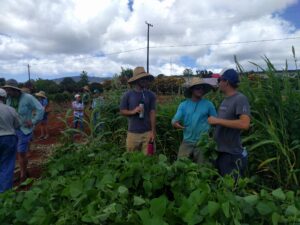
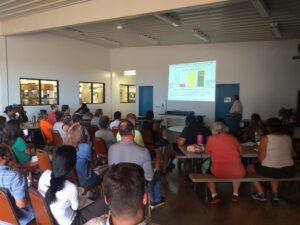
Our project coordinator and technical adviser provided cover crop consultations and site visits to all cooperating farmers at the beginning and end of the 2017 and 2018 trials, as well as an additional farmer.
We conducted an on-farm demo as part of the "Local Seeds for Local Needs" event hosted by CTAHR and GoFarm Hawaii at the Waimanalo Agricultural Research Station on September, 23, 2017. We shared information on cover crop cocktails and the trial activities, including a demo plot of sunn hemp, buckwheat and black oats.
A poster was accepted for presentation at the 2017 Hawaii Agriculture Conference, highlighting the cost and benefits of cover crop cocktails, as well as the ongoing trial. (See attached: CCC-AgConferenceFinal-LEFT CCC-AgConferenceFinal-RIGHT)
Education and Outreach Outcomes
Conducting on-farm trials on the island of Oahu involves disparate growing conditions and production systems. Knitting together the participating farms and farmers into a learning network proved more challenging than anticipated for this reason. Several small-scale, growing farms that participated in our trial were eager to refine their approach to cover cropping, but also experienced constraints in the resources they could bring to bear on the cover crop trial due to their evolving production system and the relatively small impact of cover cropping on their overall financial success. However, these challenges also provided us with a special opportunity to document farmer outlooks on the "pain points" or challenges that exist to the wider adoption of cover crop cocktails and cover crop usage in general. The highly diverse farming systems in Hawaii make it difficult if not impossible to formulate highly-refined cover cropping recommendations and one-size-fits-all solutions. This same truth applies even more so to cover crop cocktails, which require a broader knowledge base to effectively manage and adapt for a specific site. Our experience leads us to believe that the best way to serve Hawaii's small farms is to focus on cover crop and soil health decision-making tools and training opportunities. Efforts should focus on making it easy for farmers to start cover cropping successfully by systematically addressing bottlenecks, such as seed and equipment availability, as well as knowledge/skills gaps. There is a need to assess cover crops as part of broader soil health techniques that integrate weed management, which is a constant challenge on organic farms. We were encouraged by the impact of working with individuals learning to farm through outreach collaborations with the GoFarm Hawaii farmer incubator program and UH Leeward Community College's Agriculture program. Similarly, we were pleased with the insights we were able to glean from our participatory research model. Additional trials and research need to assess cover crops as one tool within a holistic approach to soil health that factors in weed management.
Participants in our 2017 cover crop field day indicated an increased knowledge of cover crop use in Hawaii (N=29, average response 9.2 on a 10-point scale).
Participants in our 2017 cover crop field day indicated a high likelihood of applying the information learned on their property (N=28, average response 8.9 on a 10-point scale).
Six cooperating farmers trialed cover crop cocktails alongside single species cover crop plantings and assessed costs and benefits, and identified "pain points" or obstacles to adopting cover crop cocktails.
Participants in our 2018 cover crop field day indicated an increased knowledge of cover crop use in Hawaii (N=13, average response 9.3 on a 10-point scale).
Participants in our 2018 cover crop field day indicated a high likelihood of applying the information learned on their property (N=13, average response 9.4 on a 10-point scale).